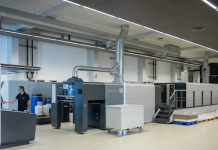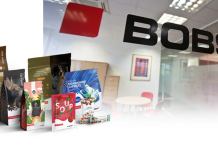Ricoh has released the TotalFlow BatchBuilder software, an easy-to-adopt, hardware-agnostic production management tool designed to allow print jobs to be batched together in the most efficient manner, freeing up valuable time and capacity while enhancing productivity and speeding up response times.
The software can adapt to any print environment to simplify and automate the batching and scheduling of short-run digital work from multiple sources for centralised job control.
TotalFlow BatchBuilder optimises the production of digital work by grouping jobs based on client-defined parameters. It organises incoming orders from multiple sources, including web-to-print, MIS or manually inputted, enabling efficient production on continuous feed or cut sheet output devices, based on different job criteria.
This solution can help with automatic scheduling and roll management for continuous feed inkjet and can perform the function of the production management queue for a web-to-print system. It is designed for commercial printers, publishing printers, centralised reprographic departments, franchise printers and service bureaux with as few as two cut sheet devices, or just one continuous feed device, or those with fleets of cut sheet and continuous feed devices, even from multiple vendors.
Peter Williams, Executive Vice President and Head of the Production Printing Business Group, Ricoh Europe explained, ‘Streamlining production is essential to maintaining profitability, but identifying ways to do this is not always easy. Printers of all types are seeking new ways to overcome the challenges of production demands from high volumes of one-offs and short-run jobs, which lead to rising labour costs, decreased efficiency and throughput, and difficulty tracking and managing jobs. Using this Ricoh–developed solution, work can be batched by a number of definable parameters, from the preferred device, format and substrate to the required finishing process, final destination or client.’
TotalFlow BatchBuilder supports integration with common web-to-print, MIS and prepress automation tools by enabling XML mapping capabilities that allow incoming job ticket information to be mapped to internal JDF job ticket fields in order to drive the batching automation. Unlike competing solutions, it provides operators with data-rich metrics, giving more insight into jobs and overall workflow. As it is based on XML, it can output JDF compatible tickets allowing it to work with most hardware and software solutions including web-to-print and MIS.
TotalFlow BatchBuilder is easy to integrate with existing solutions to filter, schedule, view and batch jobs, based on pre-set variables, in a fully-automated or semi-automated way. Prepress or production personnel can quickly and easily review BatchBuilder decisions and adjust as necessary, or design a workflow that goes directly to the print engine’s queue for specified job types.
Williams explained, ‘There are many ways commercial printers can use this innovative solution. For example, cut sheet work can be sorted and directed to a cut sheet device, while work more suited for continuous feed presses can be directed to those systems. Or all of the work for perfect binding can be run at the same time. Another way work might be batched is according to its final destination so delivery can be scheduled to leave at a certain time with the most efficient possible route.’
TotalFlow BatchBuilder also supports hot folders so work can simply be dropped into a folder, automatically adopting the pre-determined ticketing characteristics assigned to that hot folder. In addition to automating the scheduling process, TotalFlow Batchbuilder can optimise paper use and can also be used to manage work across multiple sites for operations with several locations.
‘As a flexible, hardware-agnostic solution TotalFlow BatchBuilder can be purchased as a standalone utility or bundled with presses or other software,’ said Williams. ‘It is ideal for commercial or digital printers who run as few as 40 to 80 jobs a day or perhaps as many as 1000 during peak periods. It is also well suited for publishing printers as well as B2C and B2B web-to-print environments. Wide format printers producing a variety of work on different substrates will also find it useful, since work can be grouped by the substrate choice.’





















